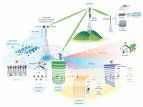 Wireless Broadband is a fairly new technology that provides high-speed wireless internet and data network access over a wide area.
Wireless Broadband is a fairly new technology that provides high-speed wireless internet and data network access over a wide area.
According to the 802.16-2004 standard, broadband means 'having instantaneous bandwidth greater than around 1 MHz and supporting data rates greater than about 1.5 Mbit/s. This means that Wireless Broadband features speeds roughly equivalent to wired broadband access, such as that of ADSL or a cable modem.
Few WISPs provide download speeds of over 100 Mbit/s; most broadband wireless access services are estimated to have a range of 50 km (30 miles) from a tower.[1] Technologies used include LMDS and MMDS, as well as heavy use of the ISM bands and one particular access technology is being standardized by IEEE 802.16, also known as WiMAX. WiMAX is highly popular in Europe but has not met full acceptance in the United States because cost of deployment does not meet return on investment figures. In 2005 the Federal Communications Commission adopted a Report and Order that revised the FCC’s rules to open the 3650 MHz band for terrestrial wireless broadband operations.[2] On November 14, 2007 the Commission released Public Notice DA 07-4605 in which the Wireless Telecommunications Bureau announced the start date for licensing and registration process for the 3650-3700 MHz band.[3]
Initially, Wireless Internet Service Providers (WISPs) were only found in rural areas not covered by cable or DSL.[4] These early WISPs would employ a high-capacity T-carrier, such as a T1 or DS3 connection, and then broadcast the signal from a high elevation, such as at the top of a water tower. To receive this type of Internet connection, consumers mount a small dish to the roof of their home or office and point it to the transmitter. Line of sight is usually necessary for WISPs operating in the 2.4 and 5GHz bands with 900MHz offering better NLOS performance.
Wireless broadband technologies also include new services from companies such as Verizon, Sprint, and AT&T Mobility, which allow a more mobile version of this broadband access. Consumers can purchase a PC card, laptop card, or USB equipment to connect their PC or laptop to the Internet via cell phone towers. This type of connection would be stable in almost any area that could also receive a strong cell phone connection. These connections can cost more for portable convenience as well as having speed limitations in all but urban.
Subscribe to:
Post Comments (Atom)





0 comments
Post a Comment